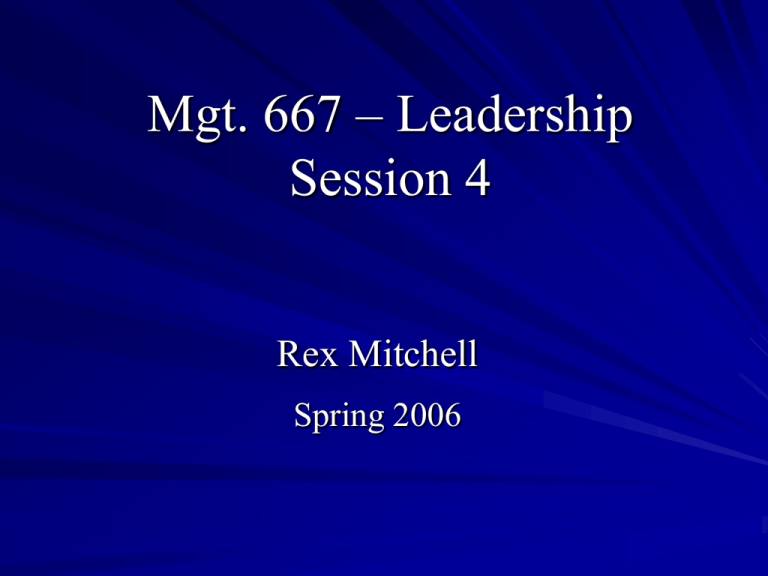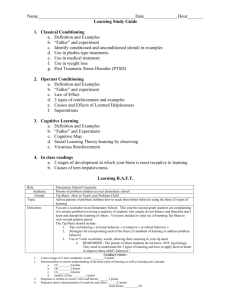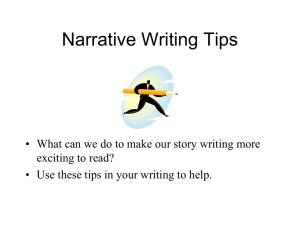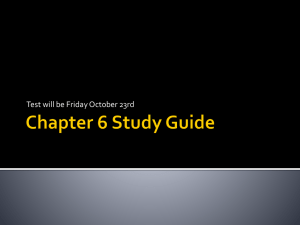Sessions 4-5
advertisement

Mgt. 667 – Leadership Session 4 Rex Mitchell Spring 2006 LPI Results & Application Objectives Analyze data to add insights re your strengths and weaknesses as a leader Choose some areas you will work on next Commit to a few actions you will take in the next three weeks to become a better leader Critical Points of View Leadership is a relationship Leadership is everyone’s business Leadership development is selfdevelopment LPI Organized Around Five Practices Model the way Inspire a shared vision Challenge the process Enable others to act Encourage the heart Your LPI Report Five practices data summary page Summary page for each of the five practices Leadership behaviors ranking page (based on peer ratings) Comparisons: – Latest 5,000 from K&P workshops – Our class Five Practices Data Summary Example Model the Way Data Summary Leadership Behaviors Ranking Leadership Behv. Ranking (low end) Percentile Ranking (K&P Data) Comparing with Our Data Means and standard deviations for our class data For each practice Self, others, total Make the Most of Your Data Look for messages in the data, not measures Accept feedback as a gift Trust the feedback you receive Value the differences Plan to use the data for action Process Receive feedback reports Do Step 1 in your Participant’s Workbook Share impressions with one person (both share) Do Steps 2-7 in Workbook on your own Share & discuss feedback with one person How We Learn From experience By example In formal educational settings Jot down a few possibilities in each section (Step 8, p.23) Leadership Development Worksheet Review example on p.26-27 Pick one Practice for focus of attention Choose 1-2 behaviors Write measurable goals Select a primary learning strategy Write 3-5 action steps to enact your strategy & achieve your goals What are some things that will make it more likely that you will actually follow through on your written plans? People are more likely to follow through if they: Make free choices about their actions Make those choices visible to others Make those choices hard to back out of Share briefly in your group: For one practice and behavior: – Goals – Strategy – Action plans Make plans to share more completely in the group via email Best Learning Practices Tip 1. Be self-aware Tip 2. Manage your emotions Tip 3. Seek feedback Tip 4. Take the initiative Tip 5. Engage a coach Tip 6. Set goals and make a plan Tip 7. Practice, practice, practice! Tip 8. Measure progress Tip 9. Reward yourself Tip 10. Be honest with yourself and humble with others Make Leadership Development a Part of Your Life Integrate this draft Leadership Development Worksheet with MyersBriggs and other data to develop your Leadership Assessment & Development Plan (due 5/11) Review your Plan at least once a month. Make notes about your progress. Make necessary changes to action plans. Create new action plans to address other leadership practices. Think about your leadership goals & strategies when you create your “to-do” lists. Schedule at least one activity every week designed to help you meet goals. Regularly reaffirm with others your development goals Find ways to get feedback from others on your progress (e.g., include a discussion of your leadership behaviors in appropriate sessions) Ch. 13. Leadership is Everyone’s Business Make a Difference Believe that you can be an effective leader Leaders make a difference (389) Leaders make a connection – between people & the present and the future (390) Leaders take us to places we’ve never been before …and wouldn’t go by ourselves Watch out for “catches” – any leadership practice can become destructive Even more dangerous is hubris – becoming arrogant & pursuing selfish ends The best-kept secret of successful leaders is love: – Staying in love with leading – With the people who do the work – With what the organization does – With those who honor the organization by using its work Leadership is not an affair of the head Leadership is an affair of the heart Personal Best Experience Think back over your leadership experiences & choose one you consider to be a “personal best” – a time when you performed at your peak as a leader For the experience you choose, ask yourself the questions on the instruction sheet (Web) & take notes Some Questions As You Write Your Personal Best Example What characterized the situation? Who was involved? Where and when did it take place? Who initiated it? What motivated you to engage in this project? How did you challenge yourself and others? What did you aspire to achieve? How did you build enthusiasm and excitement? How did you involve others? How did you foster collaboration? How did you build trust and respect? How did you build the capacity to excel? What principles and values guided you and others? How did you set an example? What structures and systems did you apply? How did you progress from one milestone to another? How did you recognize individuals? How did you celebrate successes? What lessons did you learn about leadership from this experience? Each person will share a brief (2-3 min) summary next time This means that you select from your notes on the previous questions only a few main points to present Exam At start of next class Essay questions - from K&P book No questions on cases or exercises 70 minutes for 4 of 5 questions given Closed-book Excellent answers score higher than minimally satisfactory ones Visualization Visualization Self-fulfilling prophecies Pygmalion effect, plus or minus We tend to create negative images Replace with intentional, positive images Can help in many ways, e.g.: – Public speaking – Stress reduction – Difficult interpersonal interactions – Health… Argue for your limitations and, sure enough, they’re yours. Richard Bach The greatest discovery of my generation is that human beings, by changing the inner attitudes of their minds, can change the outer aspects of their lives. William James Visualization Exercise Identify a specific future situation in which you want to perform effectively Get very comfortable and relaxed Visualize moving yourself through space and time to be in that future situation With you in that situation performing effectively and the situation playing out positively – Experience it, not observe or think about it – With input to all senses: sight, hear, smell, feel, taste Next Session Midterm “Personal Best” presentations (2-3 min each)





